In today’s Wall Street Journal I review an important Chicago-area revival of Company. Here’s an excerpt.
* * *
Sooner or later, every play becomes a history play, a time capsule whose carefully preserved contents show us something of what life was like at a particular moment in the past. Some plays, however, tell us far more than others about such moments. One of them is “Company,” the 1970 musical in which Stephen Sondheim and George Furth described what it was like to be a member of the urban bourgeoisie at the moment when America was becoming a country where marriage for life is not a normal destiny but an increasingly remote possibility. Twenty years ago, I thought that “Company” was a period piece. Today it seems prophetic, a hardheaded comedy about the way we live and love now—and its hardheadedness helps to explain why it doesn’t get done as often as it should.
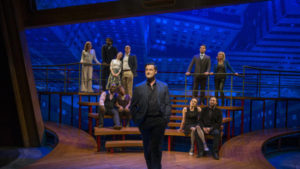 It figures, then, that first-class revivals of “Company” should be thin on the ground. I’ve reviewed only two, on Broadway in 2006 and at Pennsylvania’s Bucks County Playhouse last summer. Now there’s a third: William Brown, one of Chicago’s top directors, has given us a small-scale, contemporary-flavored “Company” (everyone uses cellphones) that is the most dramatically persuasive version I’ve seen to date. It’s the first musical to be mounted on Writers Theatre’s brand-new 250-seat main stage, and it takes full advantage of that handsome space. Indeed, the real “star” of the show is Todd Rosenthal, the set designer. Best known in New York for “August: Osage County,” he has concocted a multi-tiered performing space that shows you how the complex narrative structure of “Company” works. Everything about this production is wholly satisfying, but it’s Mr. Rosenthal’s set that makes the pieces fit together so tightly….
It figures, then, that first-class revivals of “Company” should be thin on the ground. I’ve reviewed only two, on Broadway in 2006 and at Pennsylvania’s Bucks County Playhouse last summer. Now there’s a third: William Brown, one of Chicago’s top directors, has given us a small-scale, contemporary-flavored “Company” (everyone uses cellphones) that is the most dramatically persuasive version I’ve seen to date. It’s the first musical to be mounted on Writers Theatre’s brand-new 250-seat main stage, and it takes full advantage of that handsome space. Indeed, the real “star” of the show is Todd Rosenthal, the set designer. Best known in New York for “August: Osage County,” he has concocted a multi-tiered performing space that shows you how the complex narrative structure of “Company” works. Everything about this production is wholly satisfying, but it’s Mr. Rosenthal’s set that makes the pieces fit together so tightly….
Mr. Brown and Brock Clawson, the choreographer, use this space flexibly but logically, the result being that you know at all times where you are and what you’re seeing. This lets you concentrate on the show itself, and on the acting of the 14-person cast. Everyone keeps it simple—the performances are all rendered in bright primary colors—and Mr. Sondheim’s score is both beautifully sung and played with cool clarity by the seven-piece pit band. Yet there’s no lack of passion…
* * *
Read the whole thing here.
Two excerpts from Writers Theatre’s production of Company:

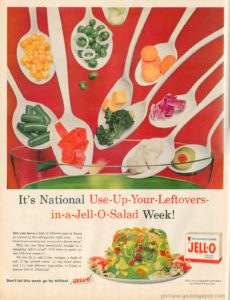 Mrs. T and I dined the other night at a “gastropub” (a neologism I dislike intensely, but we seem to be stuck with it). One of the dishes that I ordered was a salad whose constituent parts included strawberries, dried apricots, goat cheese, lightly salted Marcona almonds, and a raspberry vinaigrette. As I nibbled on an almond, I found myself thinking of the salads of my childhood, which more often than not consisted of dead-tired tomatoes and iceberg lettuce slathered in
Mrs. T and I dined the other night at a “gastropub” (a neologism I dislike intensely, but we seem to be stuck with it). One of the dishes that I ordered was a salad whose constituent parts included strawberries, dried apricots, goat cheese, lightly salted Marcona almonds, and a raspberry vinaigrette. As I nibbled on an almond, I found myself thinking of the salads of my childhood, which more often than not consisted of dead-tired tomatoes and iceberg lettuce slathered in 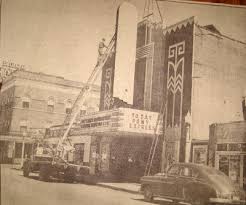 • Smalltown, U.S.A., had two movie theaters, each of which had one screen. The Malone, the respectable one, was where I
• Smalltown, U.S.A., had two movie theaters, each of which had one screen. The Malone, the respectable one, was where I 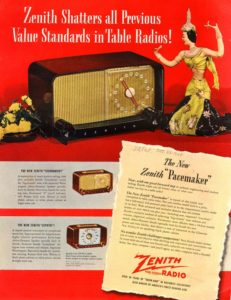 • My mother made breakfast for our family every morning, listening to
• My mother made breakfast for our family every morning, listening to  • The first McDonald’s I ever saw opened in the summer of 1968 in Cape Girardeau, a town located a half-hour north of us. The menu consisted of nine items, five of them beverages. My father sometimes took us there instead of a “real” restaurant. Far from being disappointed, my brother and I thought it a privilege.
• The first McDonald’s I ever saw opened in the summer of 1968 in Cape Girardeau, a town located a half-hour north of us. The menu consisted of nine items, five of them beverages. My father sometimes took us there instead of a “real” restaurant. Far from being disappointed, my brother and I thought it a privilege. • Since the VCR was as yet a pipe dream, all TV was “appointment” TV in the Sixties. You watched shows when they aired, when they were rerun in the summer, or not at all. We did, however, have two TV sets, a Curtis Mathes cabinet model in the living room and a black-and-white portable in the kitchen (my father was a hardware salesman, so he got a deal on it). This meant I could watch a different show when I wanted to see something in which my parents weren’t interested, so long as it was on CBS or NBC. WSIL, the ABC affiliate, was in Harrisburg, Illinois, a town so far away that the residents of Smalltown could only pick it up with a rooftop antenna. The “rabbit-ear” antennas that stuck up from the back of our portable set wouldn’t do the job, no matter how much you fiddled with them.
• Since the VCR was as yet a pipe dream, all TV was “appointment” TV in the Sixties. You watched shows when they aired, when they were rerun in the summer, or not at all. We did, however, have two TV sets, a Curtis Mathes cabinet model in the living room and a black-and-white portable in the kitchen (my father was a hardware salesman, so he got a deal on it). This meant I could watch a different show when I wanted to see something in which my parents weren’t interested, so long as it was on CBS or NBC. WSIL, the ABC affiliate, was in Harrisburg, Illinois, a town so far away that the residents of Smalltown could only pick it up with a rooftop antenna. The “rabbit-ear” antennas that stuck up from the back of our portable set wouldn’t do the job, no matter how much you fiddled with them. • I went every Saturday afternoon to the Smalltown Public Library, to which I started bicycling as soon as my parents thought me old enough to go by myself. It was a handsome building of modest proportions with a limited number of titles from which to pick the coming week’s leisure-time reading. But it was, along with network TV, my first window on the world beyond Smalltown, and so I reveled in every visit, invariably checking out three books—the maximum allowed—each time I went there. Sometimes I actually propped up a book on the handlebars of my bicycle and started reading it on the way home. This horrified my mother, with good reason. It’s a wonder I didn’t kill myself.
• I went every Saturday afternoon to the Smalltown Public Library, to which I started bicycling as soon as my parents thought me old enough to go by myself. It was a handsome building of modest proportions with a limited number of titles from which to pick the coming week’s leisure-time reading. But it was, along with network TV, my first window on the world beyond Smalltown, and so I reveled in every visit, invariably checking out three books—the maximum allowed—each time I went there. Sometimes I actually propped up a book on the handlebars of my bicycle and started reading it on the way home. This horrified my mother, with good reason. It’s a wonder I didn’t kill myself.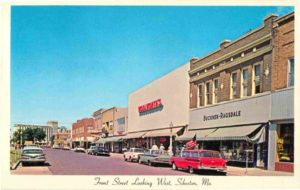 • All of the clothes that I wore as a boy came from two chain stores, Sears and J.C. Penney’s, and two locally owned stores, Buckner-Ragsdale and Falkoff’s (the second of which, I rejoice to report, is still in business). Except for Levi’s and Stetson hats, clothing brands were unheard-of back then, at least in southeast Missouri. I wore what my mother bought, and did so without complaint.
• All of the clothes that I wore as a boy came from two chain stores, Sears and J.C. Penney’s, and two locally owned stores, Buckner-Ragsdale and Falkoff’s (the second of which, I rejoice to report, is still in business). Except for Levi’s and Stetson hats, clothing brands were unheard-of back then, at least in southeast Missouri. I wore what my mother bought, and did so without complaint.
